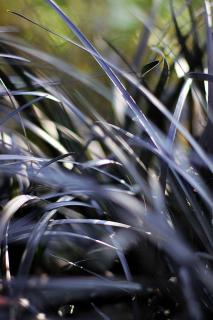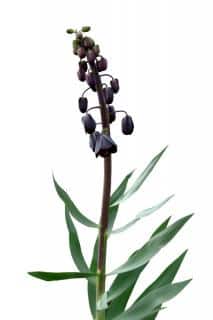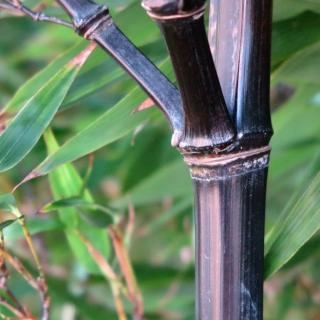

Black plants are rare in the plant realm, and that’s precisely what makes them stand out. Jet black, deep purple, ebony-colored…
Be it leaves, flowers or the branches themselves, these dark wonders seem dipped in ink. Take a look at our selection of black garden plants!
Long, thin, linear leaves unfurl in a deep black hue. Forming small, dark mounds, black Ophiopogon brings depth to your flower beds. This plant loves cool and well-drained soil, preferably with part shade exposure. It’ll form a striking counterpart to white-blooming perennials such as Arabis or anemones.
 Purple basil
Purple basilEveryone is familiar with the bright green basil tossed up with delicious mozzarella and tomato cubes in summer salads. Fresh spicy savor, but not too strong: just perfect for cooking. But did you know there were a great many basil varieties? Among these, purple basil! Shape and size are identical to the basil grown most anywhere, except for the color. It starts off deep purple and gets darker with time, turning nearly black.
Its taste matches its livery, with a distinctly more peppery touch. Why not pair it with other varieties of this versatile herb in a single garden box? The ‘Lemon’, ‘Cinnamon’, ‘Licorice’ and ‘Thai’ basil varieties will jostle for the honor of spicing up your next culinary masterpiece. Place them all in full sun and in cool soil.
The winter-hardy wavy round leaves will form a dense mound. This particular cultivar boasts black leafage that shimmers with streaks of purple, since the underside is a lighter violet color. The intense black of its leaves is undeniable, and it’s rare to see a color so deep in nature. It loves part shade and even full shade, and rich, light soil. You can pair it with hosta cultivars with golden-green leaves that will reveal the black alumroot even more.
You’ll often see them blooming in flower beds and garden boxes. Generally, Viola offers tiny, simple flowers of one or many colors. The cultivar we’re focusing on is unique in that petals have only a single color: deep velvety black. And the center is a brilliant yellow color! This ground-covering perennial blooms several times from March to December. Place them in rich, cool, and well drained soil. Favor sun or part sun.
 Iris germanica ‘Ghost Train’
Iris germanica ‘Ghost Train’Surely this iris is one of the darkest. It seems to mourn untold sadness. From May to June, frilly flowers appear and occasionally flash a blueish shine. Favor a warm full sun location, dry if possible, for this perennial. Pair it with other types of iris such as the ‘Blue Crusader’. Its stark blue flowers will carry and showcase the black variety’s blooming.
Towering 3 feet tall (90 cm), this perennial sends tall black-flowered scapes reaching for the heavens , with dashing purple edges. This perennial bulb plant is happiest in the sun with well-draining substrate. Even when it isn’t blooming, the copper-green lance-like leaves are extremely appealing as they sway on knee-heigh stems. Set Persian lily up in rocky ground or in a flower bed together with perennials, annuals and grasses. Note also the tallest of all, black hollyhock. A mysterious beauty indeed!
This Phormium variety has long, narrow black leaves that fan out into lush clusters. Growing up to nearly 4 feet (1.20m), leaves are a very deep violet color. It’s very close to black. Long, flexible leaves are the reason modern landscapers select this plant, which grows best in mild climates. Indeed, it can only cope with temperatures higher than 19°F (-7°C). Set it up in a pot, and bring it indoors for winter. Phormium appreciates aerated and rich soil that doesn’t hold water in. Full sun exposure suits it best.
 Black Bamboo
Black BambooWhen talking about bamboo, one variety in particular stands out thanks to its ebony-black canes peppered with bright green leaves. These belong to Phyllostachys nigra, which does best in rich, deep soil and part shade or full sun exposure. A slow grower, this running bamboo can be nestled in a container.
This amazingly appealing hydrangea boasts black stems, green leaves, and blue flowers. Blooming is from July to October and reveals flat-topped flower clusters that are a luminous blue tint. These pristine blue flowers definitely highlight the surprising black wood. Like all hydrangeas, this cultivar loves cool, rich, acidic and well-draining soil. You can place it in either part or full shade.